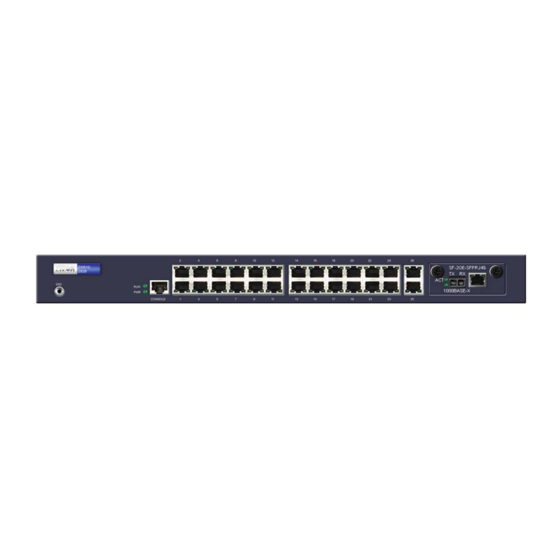
Table of Contents
Advertisement
Quick Links
ZXR10 2920/2928/2952
Access Switch
User Manual(Volume I)
Version 1.0
ZTE CORPORATION
ZTE Plaza, Keji Road South,
Hi-Tech Industrial Park,
Nanshan District, Shenzhen,
P. R. China
518057
Tel: (86) 755 26771900
800-9830-9830
Fax: (86) 755 26772236
URL: http://support. zte. com. cn
E-mail: doc@zte. com. cn
Advertisement
Chapters
Table of Contents
Troubleshooting

Summarization of Contents
About This Manual
Purpose
This manual provides procedures and guidelines for ZXR10 2920/2928/2952.
Intended Audience
This manual is for engineers and technicians operating Layer 2 switches.
Chapter 1 Safety Instruction
Safety Instructions
Details safety precautions for installation, operation, and maintenance.
Chapter 2 System Overview
Product Overview
Describes ZXR10 2920/2928/2952 as megabit L2+ Ethernet switches.
Security Controls
Covers user, equipment, and network security measures.
QoS Guarantee
Details QoS features like 802.1p, DSCP, queue scheduling, and CAR.
Chapter 3 Structure and Principle
Working Principle
Describes the switch's architecture including Control, Switching, Interface, and Power modules.
Power Supply Module
Details the two power supply modes: -48V DC and 110V/220V AC.
Chapter 4 Installation and Debugging
Equipment Installation
Describes desktop and 19-inch cabinet installation options.
Switch Installation on Desktop
Details how to install plastic pads for desktop placement.
Switch Installation onto a Cabinet
Explains how to install flanges for cabinet mounting.
Cable Lightning Protection Requirements
Discusses lightning strike damage and protection requirements.
Chapter 5 Usage and Operation
Configuration Modes
Lists multiple configuration modes: serial port, Telnet, SNMP, and WEB.
Configuring through Telnet
Explains how to configure the switch using Telnet.
Configuring through WEB Connection
Explains how to enable and use the Web management interface.
Chapter 6 System Management
Operating File System
Details file operations using CLI commands.
Setting File Backup and Recovery
Details procedures for file backups and recovery.
Software Version Upgrade
Explains the importance and process of upgrading software versions.
Upgrading Version at Abnormality
Explains the software version upgrade procedure when the system fails to start.
Chapter 7 Service Configuration
Configuring Basic Port Parameters
Describes configuration of port parameters like auto-negotiation, duplex, rate, and flow control.
ACL
Details ACL configuration, including basic, extended, L2, hybrid, and global ACLs.
VLAN
Defines Virtual Local Area Network (VLAN) and its advantages.
Configuring VLAN
Details the configuration of VLANs.
Configuring LACP
Details the steps for configuring LACP.
Configuring IGMP Snooping
Details the steps for configuring IGMP snooping.
Configuring STP
Details STP configuration steps.
Chapter 8 Access Service
Introduction
Introduces Network Access Service (NAS) for subscriber authentication and management.
Configuring 802. 1x
Describes the configuration of 802.1x on the switch.
Configuring IP Port
Describes the configuration of IP ports on the switch.
Static Route Configuration
Explains how to configure static routes for remote network connectivity.
Configuring DHCP Snooping/Option82
Describes DHCP snooping and Option82 configuration.
Configuring IP Source Guard
Describes IP source guard configuration.
Chapter 9 Network Management
Remote Access Overview
Introduces restrictive mechanisms for network management users.
Configuring Remote-Access
Details how to enable/disable restrictive remote access and configure IP addresses.
SSH Overview
Introduces Secure Shell (SSH) as a protocol for secure remote access.
Configuring SSH
Explains how to enable/disable SSH and display its configuration.
SNMP Overview
Introduces SNMP as a popular network management protocol.
Configuring SNMP
Details how to create community names, set access authority, create views, set group names, and set users.
Cluster Management Overview
Defines cluster management and its components.
Configuring Cluster
Details the steps for configuring a cluster.
Configuring a Cluster Member
Describes how to add or delete cluster members.
Chapter 10 Maintenance
Overview
Introduces routine maintenance, test methods, and troubleshooting.
Daily Routine Maintenance
Details daily checks for terminal interface, indicators, fan, temperature, alarms, connectivity, and services.
Common Troubleshooting
Covers general troubleshooting of software and hardware faults.
Troubleshooting through Console Port
Provides steps for troubleshooting via console port.
Troubleshooting through Telnet
Describes troubleshooting steps for Telnet connections.
Troubleshooting the User Name/Password
Covers issues with incorrect user name or password during login.
















Need help?
Do you have a question about the ZXR10 2952 and is the answer not in the manual?
Questions and answers